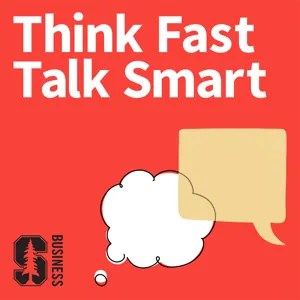Podcast Summary
Power comes from relationships and need in them: Power is about the extent of mutual need in relationships, with those needing the other less holding more power
Power is not a personal quality, but rather a resource that comes from our relationships. According to Deb Grunfeld, the Joseph McDonald Professor of Organizational Behavior at Stanford Graduate School of Business, power is about the extent to which relationship partners need one another. In other words, the person who needs the other less has more power in the relationship. Power can come from various sources, including formal reporting relationships and positional power. It's essential to understand that power dynamics exist in all facets of our lives, both at work and at home. If you're interested in learning more about power and how to navigate it effectively, be sure to send your communication questions to stanfordbusiness@stanford.edu by June 30th. We'll pick some questions and answer them on an upcoming episode of Think Fast, Talk Smart. So, whether you're grappling with power dynamics at work or at home, we'd love to hear from you.
Understanding Power Dynamics in Relationships: Power dynamics exist beyond formal structures and impact behavior. Equality may not be achievable, but managing differences can maintain balance. Projecting power involves directness and stillness, conveying confidence and authority.
Power dynamics exist in various relationships beyond formal reporting structures, and they can significantly impact how individuals behave and interact. In peer relationships, marriages, and other contexts, power differences can lead to one person feeling more reliant or subordinate. Equality may not be achievable in all aspects, but managing power differences can help maintain balance. Regarding nonverbal behavior, projecting power involves being "on the square" – facing someone directly with an even weight distribution, and maintaining stillness and focus in your energy and body language. This stillness and directness convey confidence and authority, making a significant impact on your relationship with others. By being aware of these power dynamics and nonverbal cues, we can better understand and navigate our interactions with others.
Body language and use of space shape perceptions of power: Expansive posture and open body language convey confidence and generosity, while intimidating others with aggressive gestures or invasive personal space can be avoided through awareness and practice.
Our body language and use of space significantly impact how others perceive our power. Being physically expansive through open chest, shoulders, and maintaining a balanced and still posture conveys confidence and generosity. On the other hand, moving into others' personal space or using aggressive gestures like pointing can intimidate or threaten. Practicing these nonverbal cues can help shift power dynamics in our favor. Additionally, recognizing how we use space and experimenting with giving others more room can convey a sense of respect and submission. It may feel unnatural at first, but with practice, we can grow and develop new ways of communicating power effectively.
Understanding power dynamics in communication: Be aware of power dynamics in communication scenarios and focus on the other person to effectively influence and communicate with impact
The words we use and the way we speak can significantly impact our perceived power and authority. Complete sentences with clear beginning and end points convey confidence and decisiveness, while hedging language like "kind of," "sort of," and "I think" can undercut our mojo and leave us open to being questioned or challenged. However, there are also situations where expressing uncertainty can be disarming in a positive way. The key is to be purposeful in our use of language and make conscious choices rather than relying on habits. One of the best communication advice received was "The most important person in the scene is never you." This advice, given by a director to two actors practicing a conversation, emphasizes the importance of recognizing and focusing on the power dynamics in a scene, rather than being overly self-conscious and concerned with our own performance. By shifting our focus to the other person, we can effectively communicate with more impact and influence.
Focus on others to communicate effectively: Effective communication requires focusing on the needs of others and making them feel valued, as demonstrated by Governor Andrew Cuomo's leadership during crises.
Effective communication involves focusing your attention on the other person and making them feel valued, which in turn allows you to communicate without fear or anxiety. A communicator I admire who embodies this quality is New York Governor Andrew Cuomo. He understands that as a leader, his primary duty is to serve others and provide security during times of crisis. Despite his own personal challenges, he communicates in a calm and reassuring manner, giving his audience a sense of confidence and stability. It's not about having all the answers or engaging in petty fights, but rather about showing up every day and performing the role of a leader. By focusing on the needs of others, we can build stronger connections and be more effective communicators.
Effectively communicating power: Own your power, understand context, and have a generous heart are key to successful communication. Elon Musk is a great example of this approach.
Effectively communicating power involves owning it, understanding the broader context, and having a generous heart. According to Deb, a great example of this can be seen in Elon Musk's leadership. He not only commands authority but also understands the importance of performing a role for his audience. Deb emphasized that effective communication goes beyond just the words spoken and requires an awareness of the social rules, the part we're playing, and the visual focus. In summary, owning your power, understanding the context, and having a generous heart are essential ingredients for successful communication. For those learning English as a second language, the new ELL webpage at faster smarter dot I o slash e l l offers practical advice and resources to help feel less anxious and more authentic in communication.

